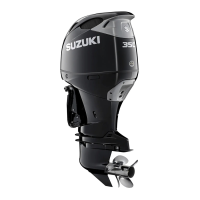12
NOTE:
• Drill the mounting holes vertically to the transom board.
• Drill the upper holes at least 25 mm (1.0 in) down from the transom top surface.
• To insure water-tightness, sealant (SUZUKI SILICONE SEAL or equivalent) should be applied to all bolt
holes. Apply the sealant to the shanks of the bolts, but not the threads.
• Do not use an impact tool to tighten or loosen the transom nuts.
• If the specified tightening torque can not be reached due to weak transom material, it may be necessary to
install a reinforcement plate to the transom board. If a reinforcement plate is required, contact the boat
manufacturer for recommendations. The transom reinforcement plate should be installed between the
transom surface and the washer B and /or D.
NOTICE
NOTICE
NOTE:
If there is a clearance between the clamp bracket and the tran-
som top surface, place a proper spacer on the transom top sur-
face so that the motor weight can be supported by the transom
through the spacer.
NOTE:
Make sure that there is no clearance on matting surfaces
between the transom board and motor clamp brackets.
Otherwise, the motor clamp brackets may be damaged.
NOTICE
Use of hand tools: turning a lock nut E at high speed
with impact tool may damage the friction ring (nylon).
Do not use an impact tool to tighten or loosen the
transom nuts E.
Never reuse the lock nut E after it has been threaded
into position and torqued.
Once you have tightened the lock nut E, it will no
longer have the necessary fastening performance if
you reuse it.
Spacer
If the motor is not properly secured to the transom, it
can come off.
After completing break-in operation (10 hours), re-
tighten the transom nuts to the specified torque.

